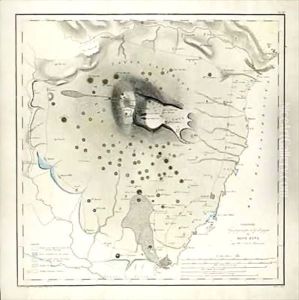Elie de Beaumont Paintings
Jean-Baptiste Armand Louis Léonce Elie de Beaumont, known as Elie de Beaumont, was not an artist in the traditional sense but rather a prominent French geologist born on September 25, 1798, in Canon, near Bayeux in Normandy, France. He is mainly recognized for his work in the field of geology rather than the arts. Elie de Beaumont's contributions to the earth sciences are substantial, and he is considered a key figure in the development of geological theory during the 19th century.
Elie de Beaumont studied at the Lycée Henri-IV and went on to the École Polytechnique in Paris before transferring to the École des Mines (School of Mines) in 1819. He graduated with an engineering degree and embarked on numerous geological surveys, notably co-authoring an important geological map of France alongside his colleague and mentor, André Brochant de Villiers.
His career was marked by a keen interest in mountain formation and geological structure. One of his most significant theories was the 'theory of the parallel chains,' in which he proposed that mountain ranges across the globe were of the same age based on their directionality and structure, a concept later proved incorrect. Despite this, his work was influential in the understanding of orogenesis, the process of mountain formation.
Elie de Beaumont's academic prowess led to his election to the French Academy of Sciences in 1835, and he later served as its president. Additionally, he was appointed as a professor of geology at the Collège de France in 1838 and held the position until his death on September 21, 1874, in Canon. Over his career, Elie de Beaumont published numerous papers and works on geological subjects and remained a respected figure in the scientific community throughout his life, despite some of his theories being contested or refuted by later research.
It is important to note that while Elie de Beaumont's name may be associated with artistic endeavors due to the common confusion between different fields and the occasional overlap between art and science in historical contexts, his legacy lies firmly within the realm of geology. His contributions have helped to shape our understanding of the Earth's geological history and processes.
